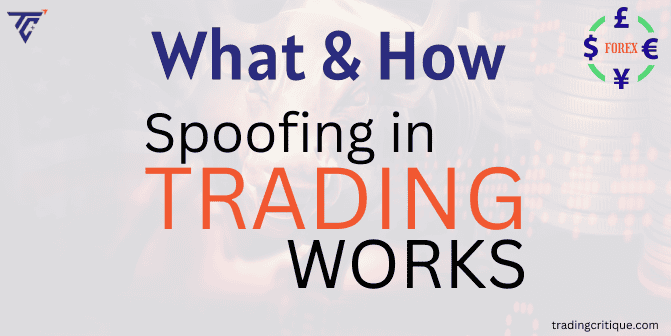In trading, spoofing generally refers to a form of market manipulation where traders place large orders with no intention of executing them. The motive is to deceive other market participants into believing there is significant buying or selling around a particular price level.
Quick insights
What is Spoofing in Trading?
What is spoof trading? Spoofing refers to a deceptive practice, and it involves faking or impersonating someone or something to gain an advantage. Whether it is good or not depends upon the context, but in most cases it is unethical.
Spoofing in trading involves practice of placing large orders with the intent to cancel the bids before they are executed. The goal is creating a false impression of market demand or supply and tricking other traders into making decisions by offering misleading information on trading platforms.
How Does Spoof Trading Work?
Traders hope to move the market in a favorable direction so that they can cancel the large orders before it is executed and profit from the price movement. Here is how spoofing typically works:
Placing fake orders
Traders submit large orders, either buy or sell, at the price levels that they don’t intend to fill. By this, they create the illusion of strong demand or supply in the market.
Market reaction
Other traders tend to react to the large orders, thinking that it indicates market sentiment and they try to adjust their own orders accordingly.
Canceling the orders
The spoofing traders then cancel the large orders before they can be executed after the desired price movement has occurred.
Profiting
The traders take advantage of the price movement to execute smaller, genuine orders at the more favorable price.
How to Detect Spoofing in Trading?
It is quite easy to detect spoofing in trading by identifying suspicious patterns and behaviors that deviate from normal market activity. One should be able to perform careful monitoring of order book activity, and the use of advanced tools or algorithms to detect spoofing. Expert traders and regulators use enormous techniques to spot spoofing as follows:
Layering
Spoofers usually place orders at multiple price levels, which is a strategy called layering. In order to create the illusion of a significant supply or demand, they place a large number of smaller orders at different price levels. When you see several orders stacked at various price levels, and they are quickly canceled as well, then you can be sure it is a possible sign of spoofing.
Iceberg orders are large orders broken into smaller ones in order to hide the full size. You can confirm these as spoofing if it doesn’t result in actual trades.
Unusual order book activity
There might be cases where large orders are quickly canceled. Spoofers place bidding or offering orders far from the current market price, only to cancel orders before they are executed. When you see such large orders that may frequently appear and disappear, this could be a sign of spoofing.
A huge order that is too large for the market to handle could also be spoofing, particularly if that order is pulled before being executed. A sudden appearance of large buy or sell orders that are not executed but cause the market to move can also be an indication of spoofing.
Price movements without corresponding real orders
Price sometimes moves dramatically based on large orders that are later canceled. This suggests that such orders were never meant to be executed buy only used to manipulate the market. You might also see sudden and sharp price movements with no major events to justify. Such changes could be linked to spoofing, particularly if they are driven by fake orders.
Market depth analysis
Analyzing the depth of market is one of the best ways to spot spoofing. When the depth shows orders that are disproportionately large compared to the surrounding market activity, and they disappear quickly, this could signal that spoofing is occurring.
Regulatory surveillance
Major exchanges and regulators make a regular monitoring of the trading activities for spoofing behavior. Since they use sophisticated tools to detect patterns of manipulation, spoofers may be flagged for investigation.
Spoofing indicators
Order book heatmaps and price movements vs volume analysis are the popular spoofing indicators to help detect. Visual representations of order book activity may help identify large orders placed for short durations. Sudden price changes without corresponding volume may also suggest spoofing activity. We should also beware of AI stock trading when relying on them.
Behavioral patterns
Spoofers generally use consistent and repetitive behaviors such as placing large orders and canceling them quickly. When you recognize such patterns, you can spot potential spoofing. Also, when you see large orders repeatedly placed but never executed, it is an indicator that the order might have been placed only to manipulate markets.
Legal Consequences & Regulations Against Spoofing
There have been numerous cases of traders being fined or charged for spoofing in trading. Engaging in spoofing in trading can lead to serious legal and ethical repercussions. Regulatory authorities around the world take aggressive action to prevent and punish market manipulation. Below are a few of the legal consequences of spoofing:
Criminal penalties
Individuals found guilty of spoofing may even face imprisonment, upto 10 years. In the United States, penalties for market manipulation can reach upto $1 million for individuals and higher for organizations. In few cases, spoofers may be required to pay restitution to victims.
Civil penalties
Regulatory authorities like SEC and FCA may impose substantial civil fines on those engaged in spoofing. Traders may also be required to forfeit any profits made from spoofing.
Market bans
If a trader or a firm is found guilty of spoofing, they may face a suspension from trading in financial markets. Regulators can impose temporary or permanent bans on individuals or firms involved in spoofing, by preventing them from accessing certain financial services.
Regulatory investigations
Regulatory bodies actively investigate instances of market manipulation, including spoofing. Since they monitor market activity for suspicious patterns, they can launch investigations against suspected spoofers.
A regulatory investigation may generally lead to enforcement actions, penalties, or additional scrutiny from financial authorities.
Class action lawsuits
Victims, who were affected by spoofing activities can file private lawsuits or participate in class action lawsuits seeking damages. Such lawsuits may result in large settlements or awards. Civil lawsuits could result in substantial compensation for damages, such as
- Compensatory damages for direct losses
- Punitive damages that are meant to punish the perpetrator
Below are the key regulations and laws against spoofing:
- The Commodity Exchange Act (CEA) in the US prohibits market manipulation in commodity markets, including futures, options, and swaps. This act also includes spoofing, which is a form of market manipulation.
- The Dodd-Frank Act made spoofing illegal under US law, particularly amending the Commodity Exchange Act to include provisions on manipulation and spoofing.
- The Securities Exchange Act of 1934 monitors trading in US securities markets and includes provisions aimed at preventing manipulation, including spoofing.
- In the European Union, Market Abuses Regulation (MAR) focuses in preventing market abuse, including manipulation such as spoofing. MAR applies to all financial markets of EU and gives regulators like European Securities and Markets Authority (ESMA) and national authorities the power to investigate and take enforcement actions against spoofing.
- The Commodity Futures Trading Commission (CFTC) has been very active in prosecuting spoofing cases and enforces regulations to prevent spoofing specifically in the futures markets.
- The Financial Conduct Authority (FCA) in the UK oversees financial markets and ensures that spoofing like market manipulation is prevented.
- The International Organization of Securities Commissions (IOSCO) provides guidance for the financial markets regulation and it includes measures to prevent market manipulation.
Conclusion
Since spoofing distorts the natural price discovery process and typically leads to unfair market conditions and disruptive trading, it is considered illegal in most jurisdictions. Regulatory bodies such as the SEC (Securities and Exchange Commission) and CFTC (Commodity Futures Trading Commission) in the US actively monitor and penalize.
Regulators worldwide have implemented strict laws and regulations to combat spoofing, and violators may face significant penalties, including fines, bans, and jail time. We recommend traders execute trades with integrity and follow the rules, which is crucial for maintaining a fair and transparent market environment. You can also check out how automated trading systems work.
Pro Tip
Though it is easy to spoof the market, it is a serious market manipulation tactic and one should avoid such practices. Get a suitable broker from our broker finder tool as our best forex brokers help you enhance your trading journey hassle-free. Check our wide range of investment options like, stock, banking, finance, and crypto for a diversified trading.









